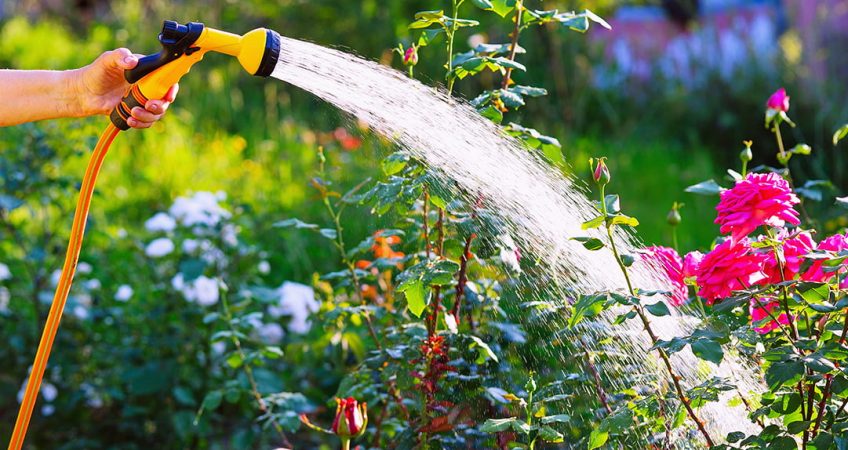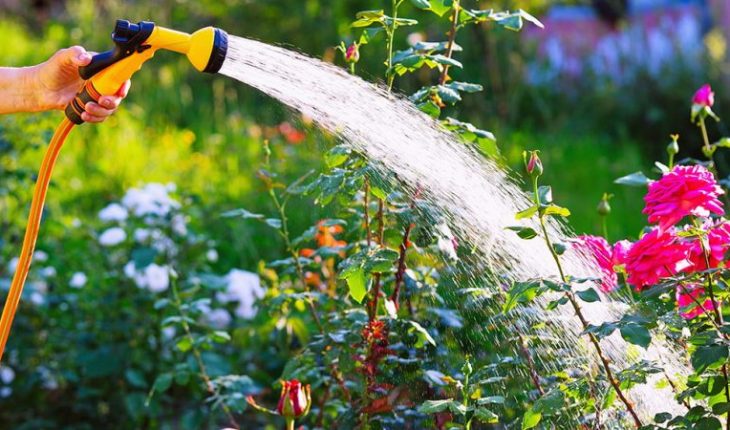There’s more to watering than some may think. To effectively and efficiently irrigate your garden, you need to know what part of the day is the best time to water, which irrigation methods are most effective, how much to water, how watering relates to diseases, and more. Most vegetable and ornamental gardens need an inch of water per week, spread evenly and applied using a method that allows it to penetrate deeply. It’s possible that you are spraying quite a bit more than that at your garden, watering more often than necessary, and still leaving your plants starving for more.

Sprinklers: Okay for lawns, not a good idea for gardens
Some contend that using a sprinkler to spray water into the air allows it to gather nutrients before it falls onto the plants. While it’s true that rainwater is best for plants because it becomes infused with nitrogen as it falls through the atmosphere during a thunderstorm and doesn’t have the chemicals found in processed drinking water, any nutrients water from a sprinkler could possibly gather would be insignificant. It’s also virtually impossible to target specific areas using sprinklers, thus they’re inefficient.
Another problem with sprinklers is that they wet the plants’ leaves. Repeatedly applying drops of water to the leaves can actually promote diseases caused by fungi and bacteria. Bacteria potentially harmful to plants gets released by the water droplets. Fungal spores on leaves need water to germinate and grow. The continued splashing of water on the leaves allows these disease pathogens to spread and infect other plants nearby. You can’t stop rain from causing this, but you can stop doing it, yourself, by using a sprinkler.
Deep watering
Deep watering refers to applying water directly to the top of the soil using a hose or other irrigation method at a rate that allows the water to penetrate six to eight inches without runoff. This reduces evaporation during hot summer months and promotes deep root growth. Plant roots will extend farther into the soil to reach the deeper moisture and will, in turn, absorb more nutrients they would not have otherwise accessed. Watering every day using a less efficient method will not result in deep penetration and will not promote healthy root growth.
Depending on your soil, where you live, and whether you are getting normal amounts of rainfall, you may only need to water every ten days or so using deep watering methods. In warmer climates, deep watering may allow you to water every three to five days. This doesn’t apply to plants in containers. Those may still need daily watering.
Testing and application methods for deep watering
Because deep watering requires you to limit the flow so that the water has time to penetrate rather than being lost to runoff, a standard garden hose probably isn’t the best tool for the job. Drip irrigation and soaker hose systems are more effective. With either of these, you can evenly provide water to large areas at slow enough rates to allow it to penetrate deeply without runoff. Soaker hoses and drip irrigation systems also apply water at the base of the plants rather than to the leaves.
You’ll need to perform a little trial-and-error testing to get your flow rate dialed in using these irrigation tools. First, adjust the water flow to determine how much water you can apply without runoff. Start a timer, let the irrigation system run for a few minutes, then dig a small hole in the soil. Determine how deeply the water has penetrated. If it’s reached eight inches and you still aren’t getting runoff, check your timer and note how long it took to do so. If it hasn’t reached eight inches, wait a few minutes and check again. Once you’ve determined your flow and penetration rates, you simply repeat it each time you water. Bear in mind that, depending on your soil, your drip irrigation or soaker hose may need to run at very low flow for several hours to accomplish your goal.
When to water
Avoid irrigating during the heat of the day. You’ll lose water to evaporation. Water early in the morning or in the evening. If you can’t bring yourself to give up the sprinkler, using it during in the hot part of the day will make it more likely that diseases will develop. Use it only during early morning hours so that the morning sun will dry the leaves and hopefully minimize bacterial and fungal growth.
If you begin to see wilting leaves, that’s a good indication that it’s time to irrigate. For vegetable gardeners, plants with large, tender leaves like cucumbers will be the first to let you know when your plants are thirsty.
Automated irrigation
Perhaps you don’t want to check for wilting leaves and hang around the house for several hours at a time while deep watering your garden. There are inexpensive timers available online and at home and garden stores. They aren’t expensive and you can use them to automate your irrigation system. You’ll just need to shut them off if you’re receiving or expecting rainfall to avoid wasting water.
Compost and mulch
Periodically adding a good organic compost to your garden soil will add nutrients and keep it loamy, allowing the water and nutrients to get where they need to go.
Covering your garden with mulch will significantly reduce evaporation, holding moisture in and allowing you to water with less frequency.
In closing…
Using more effective and efficient methods to irrigate your garden will not only save water, but can also protect your plants from diseases. Deep watering methods promote healthy root growth and help your plants thrive. Regular applications of compost and mulch will reduce the need to irrigate, add nutrients, and allow water to penetrate more deeply in less time. If you’re watering your garden daily, you’re working too hard and you’re not getting the best results possible.

